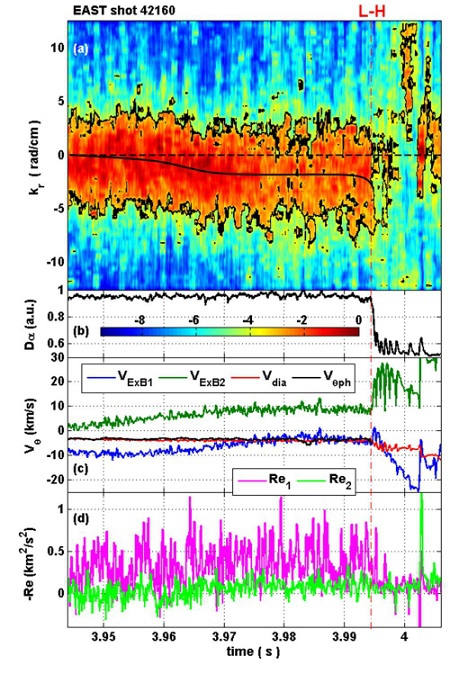
count: [2016-03-17] [Close]
A significant progress towards the better understanding of the mechanism underlying turbulence suppression at the low-to-high (L-H) confinement transition has been made in the latest research on the Experimental Advanced Superconducting Tokamak (EAST) in the Institute of Plasma Physics, Chinese Academy of Sciences (ASIPP).
In a recent experiment, probe measurements and model analysis were carried out by EAST team. For the first time, it was observed that the L-H transition occurred spontaneously mediated by a shift in the radial wave number spectrum of turbulence. Radialwavenumber spectral shift and turbulence structure tilting took place tens of millisecondsprior to L-H transition atthe plasma edge. Across the L-H transition, the spectral shift accelerated, and the local turbulence got suppressed. In addition, the spectral shift appeared to be correlated with the time evolution of radial electric field shear at the plasma edge. In the geometry space,the spectral shiftmanifests itself as ordered turbulence eddies tilting, which scattersthe turbulent energy to higher wave number region where the turbulence energy is dissipatedIt leads to local turbulence suppression.
The mechanism for the L-Htransition is a 34-year long standing mystery in the field of magnetic fusion. It has been widely conceived that shear flows play a key role in L-H transition. However, the origin of shear flows and how shear flows lead to turbulence suppression are still ambiguous. Thusthe evidencediscoveredinthe recent EAST experiment will contribute to the understanding of this important problem in the field of magnetic fusion.
The high-confinement mode (H mode) is the projectedbaseline operational scenario for the International TokamakExperimental Reactor (ITER).ITER relies on the high confinement of H-mode to achieve it scientific mission. However, at the beginning of ITER operation, its auxiliary heating power will be very limited. There is still uncertainty for the H-mode access on ITER in its early phase. Therefore, improvement on the understanding of the L-H transition is rather demanding. (Ning YAN and Xingquan WU report)
Although recent work on EAST still can't fully uncover the mystery of "L-H transition", these new findingsrepresent a substantial and novel advance in this important area of magnetic fusion research, which may open a new path ofinquiry in future work. The related work has been published recently inPhysical Review Letters(Xu G S, Wan B N, Wang H Q, et al. Physical Review Letters 2016 116 095002).
Link of the article: http://journals.aps.org/prl/abstract/10.1103/PhysRevLett.116.095002

FIG. Time evolution of (a) radial wave number spectrum displayed in log scale, spectral-averaged radial wave number <kr> as indicated by black curve, (b) divertor Dα emission, (c) Er ×B velocity VE×B at two radial locations, diamagnetic drift velocity Vdia and poloidal phase velocity of fluctuations Vθph with negative velocity standing for the electron diamagnetic direction, (d) turbulent Reynolds stress at ~5 mm inside the separatrix for Re1 and approximately on the separatrix for Re2.